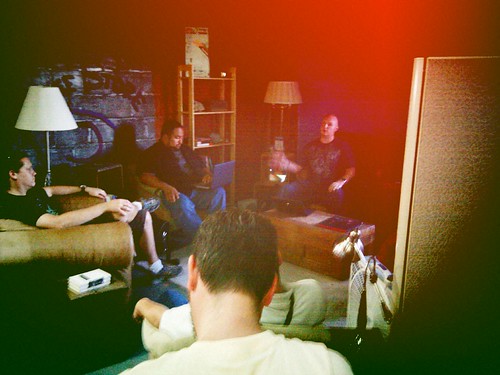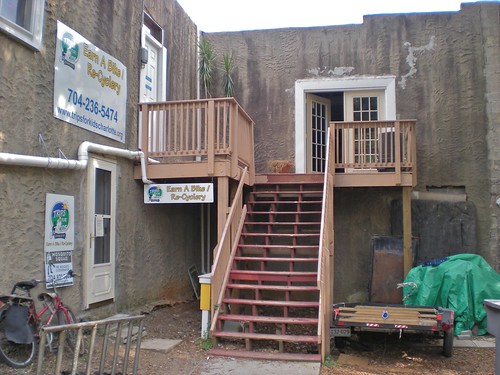 Yesterday, I attended Charlotte's fourth Barcamp at Area Fifteen. Area Fifteen is a former industrial space re-purposed ad hoc to serve a bevy of small businesses. Of the ones I know about, these outfits include a bicycle re-cyclery, office spaces for small businesses, a dance studio, a concrete furnishings workshop, a "free store", a barista training center, a prayer room, a coffee shop, a jewelry/accessory storefront, a massage/tea blending happiness center, artist spaces, Jared's rabbit hole and ...who really knows what else? Located throughout the complex are many break out areas and assembly spaces, including decks and transition areas/docks, with a large side yard for event parking, outdoor art markets/gatherings and a vegetable garden. There's something about the loose organizational structure of Area Fifteen that lends itself very well to the equally loose, ready-to-mix ethos of a Barcamp "unconference". The fact that Area Fifteen has enough leftover space within it to host a random gathering of geeksters and entreprenuers says quite a lot about the virtues of this place.
Yesterday, I attended Charlotte's fourth Barcamp at Area Fifteen. Area Fifteen is a former industrial space re-purposed ad hoc to serve a bevy of small businesses. Of the ones I know about, these outfits include a bicycle re-cyclery, office spaces for small businesses, a dance studio, a concrete furnishings workshop, a "free store", a barista training center, a prayer room, a coffee shop, a jewelry/accessory storefront, a massage/tea blending happiness center, artist spaces, Jared's rabbit hole and ...who really knows what else? Located throughout the complex are many break out areas and assembly spaces, including decks and transition areas/docks, with a large side yard for event parking, outdoor art markets/gatherings and a vegetable garden. There's something about the loose organizational structure of Area Fifteen that lends itself very well to the equally loose, ready-to-mix ethos of a Barcamp "unconference". The fact that Area Fifteen has enough leftover space within it to host a random gathering of geeksters and entreprenuers says quite a lot about the virtues of this place. In don't think these sorts of venues can exist without a ready-to-use informality to them that suggest an atmosphere of easy adaptability and freedom. The sheer diversity of users and rapid turnover of activities always amazes me about Area Fifteen. I expect the place to be literally different every time I step inside. Area Fifteen, of course, is an "incubator space" of sorts, except without much of the pretension. Some activities prosper there for profit, others for not. Characters come and go. Some uses flop and others, becoming resilient, grow and move out to bigger and better things, much as Jane Jacobs observed some 50 years ago about the tendency of Brooklyn's small industrial flex-spaces to spin out ventures to the suburbs.
In don't think these sorts of venues can exist without a ready-to-use informality to them that suggest an atmosphere of easy adaptability and freedom. The sheer diversity of users and rapid turnover of activities always amazes me about Area Fifteen. I expect the place to be literally different every time I step inside. Area Fifteen, of course, is an "incubator space" of sorts, except without much of the pretension. Some activities prosper there for profit, others for not. Characters come and go. Some uses flop and others, becoming resilient, grow and move out to bigger and better things, much as Jane Jacobs observed some 50 years ago about the tendency of Brooklyn's small industrial flex-spaces to spin out ventures to the suburbs.  |
| Members of Area15 are introduced at one of the Barcamps |

 There was an insight here about approach. What is the resource? Compare the gregarious workspace of Area 15 with the acres of mostly vacant air-conditioned carpet at your local convention center. Conventions are useful and nice, and pretty darn expensive to run and attend. But what is the return on their value really? I would say that the horizon for your industry is rather limited if you depend on conventions to tell you what's next. I mean, just a thought. You're not really at a convention to integrate what's new, but to kind of participate in, well, conventional adoption. People go to Barcamp to find out why conventional wisdom is wrong. The claim of one session at Barcamp was that volume of (automated!) posting can catapult your presence on Twitterspace. Which led to some interesting discussions. You're not at a barcamp to find out how you are falling short of next-wave normal. You're at a barcamp to "network", but the kind of networking that is a heat-seeking learning process, testing the idea space, hopefully leading you to bump into others who can help you move an idea. I would argue that it is these kinds of situated, local connections made in a ripe time and place that bring sparks to a city's industries.
There was an insight here about approach. What is the resource? Compare the gregarious workspace of Area 15 with the acres of mostly vacant air-conditioned carpet at your local convention center. Conventions are useful and nice, and pretty darn expensive to run and attend. But what is the return on their value really? I would say that the horizon for your industry is rather limited if you depend on conventions to tell you what's next. I mean, just a thought. You're not really at a convention to integrate what's new, but to kind of participate in, well, conventional adoption. People go to Barcamp to find out why conventional wisdom is wrong. The claim of one session at Barcamp was that volume of (automated!) posting can catapult your presence on Twitterspace. Which led to some interesting discussions. You're not at a barcamp to find out how you are falling short of next-wave normal. You're at a barcamp to "network", but the kind of networking that is a heat-seeking learning process, testing the idea space, hopefully leading you to bump into others who can help you move an idea. I would argue that it is these kinds of situated, local connections made in a ripe time and place that bring sparks to a city's industries.  It got me back to thinking about the world-scenario ingredients of the Institute for the Future's 2010 Map of the Decade. In Aesop's parable of the Oak and the Reed, a strong wind uproots a rigid tree, but a reed, being able to bend in the wind, survives. One lesson: The mighty are usually not very adaptive.
It got me back to thinking about the world-scenario ingredients of the Institute for the Future's 2010 Map of the Decade. In Aesop's parable of the Oak and the Reed, a strong wind uproots a rigid tree, but a reed, being able to bend in the wind, survives. One lesson: The mighty are usually not very adaptive.  The IFTF four world-scenarios (briefly described in my last post) are presenting four points on a conceptual two-item sliding scale of world-future possibilities. This single-contrastive line is traveling along an imaginary axis measuring the extent of organizational adaptation/innovation under different global realities and constraints. Toward the one end of the sliding scale are worlds that see relatively little organizational adaption that lead to fundamental changes in infrastructural systems. These are the Growth and Collapse scenarios. These are the Oak worlds. The Growth world sees progress as conventional growth - the bigger the oak the better, and the Collapse scenario is that tree uprooted by the storm. On the other end are worlds that employ fundamental changes to the extent that they are able to - these are the Constraint and Transformation scenarios. Both of these worlds allow "reeds" of progress to adapt to uncertain conditions. In the case of the Transformation scenario, circumventing institutional, oak-ways of doing things is de rigueur.
The IFTF four world-scenarios (briefly described in my last post) are presenting four points on a conceptual two-item sliding scale of world-future possibilities. This single-contrastive line is traveling along an imaginary axis measuring the extent of organizational adaptation/innovation under different global realities and constraints. Toward the one end of the sliding scale are worlds that see relatively little organizational adaption that lead to fundamental changes in infrastructural systems. These are the Growth and Collapse scenarios. These are the Oak worlds. The Growth world sees progress as conventional growth - the bigger the oak the better, and the Collapse scenario is that tree uprooted by the storm. On the other end are worlds that employ fundamental changes to the extent that they are able to - these are the Constraint and Transformation scenarios. Both of these worlds allow "reeds" of progress to adapt to uncertain conditions. In the case of the Transformation scenario, circumventing institutional, oak-ways of doing things is de rigueur. It is easy to argue that the Transformation scenario is the one furthest along the process of infrastructural restructuring (or at least has the greatest capacity for such). The Constraint scenario is undergoing some fundamental restructuring due to its institutional refocus on ledgers assessing "Gross National Happiness", but, in a low-capital world, it has less investment capacity and broad cross-organizational ability to employ wholesale and unfamiliar infrastructural changes (what the IFTF calls "superstructuring").
Here is the thing I notice about the denizens of Area 15 and barcamps ...the people there are the sort that sniff for the kind of changes and "reed" models that lead to fundamentally new ways of doing and valuing things. Growth constructs lead to convention center ways of approaching industries, effective while the wind behaves, but Area Fifteens are where I suspect our next decade's reeds will sprout.



No comments:
Post a Comment